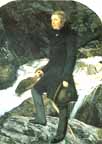 The formal portrait of John Ruskin by Sir
John Everett Millais (1853) captures the great art
critic and PRB inspiration in a style that fulfills
Ruskinian ideals. He stands elegantly
and naturally on the rocky edge of a cascading
waterfall with luscious flora occupying the upper
register of the canvas. As if directly responding to
Ruskin's arguments for detail and truthful
representation, Millais carefully renders the
individualized facial features of his subject, the
particular grooves in his hat, and the design of
clothing and shoes. The figure, therefore, seems real
and specific-- as opposed to the generalization of an
anonymous model. The realism captures a precise
moment, perhaps a moment of quiet reflection or
meditation, suggesting the artist painted at the
scene, from nature.
The formal portrait of John Ruskin by Sir
John Everett Millais (1853) captures the great art
critic and PRB inspiration in a style that fulfills
Ruskinian ideals. He stands elegantly
and naturally on the rocky edge of a cascading
waterfall with luscious flora occupying the upper
register of the canvas. As if directly responding to
Ruskin's arguments for detail and truthful
representation, Millais carefully renders the
individualized facial features of his subject, the
particular grooves in his hat, and the design of
clothing and shoes. The figure, therefore, seems real
and specific-- as opposed to the generalization of an
anonymous model. The realism captures a precise
moment, perhaps a moment of quiet reflection or
meditation, suggesting the artist painted at the
scene, from nature.
The rocks, water, and flora around the subject likewise fulfill Ruskinian ideals of color and depth. Rocks appear gray and blue with detailed green and ochre moss. The vegetation recedes smoothly into a realized three-dimensional space behind the subject, juxtaposing the cool aqua blues of the background with the warm fleshy tones of Ruskin's skin.
Questions
1. Other than the realistic rendering the subject and his surroundings, what else indicates that this painting is a production of a PRB artist?
2. Could the idea of quiet reflection with nature fit in with PRB ideals?
3. How does this style of portraiture differ from other styles, both directly preceding the PRB and during?
4. What size of market existed for portraiture as opposed to daily-life genre painting? Was portraiture exclusively for upper-class buyers who could afford the luxury of decorating their interiors with their own faces?
Bibliography
Wood, Christopher. The Pre-Raphaelites. New York: Studio/Viking, 1981.
The Pre-Raphaelites. London: Tate Gallery/Allen Lane, 1984.
Last modified 28 September 2004